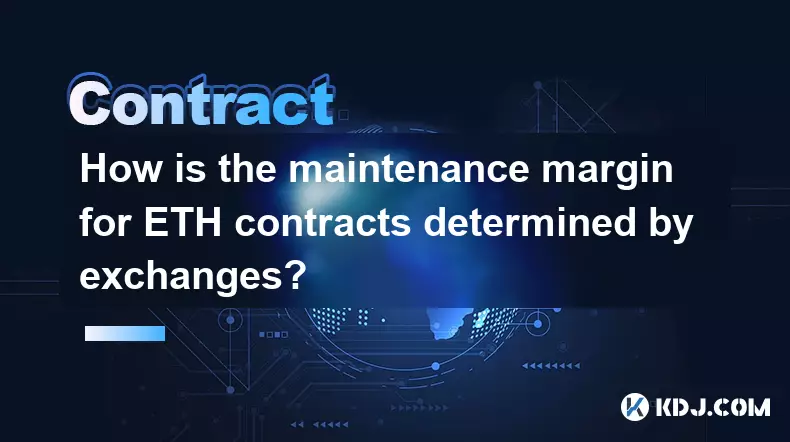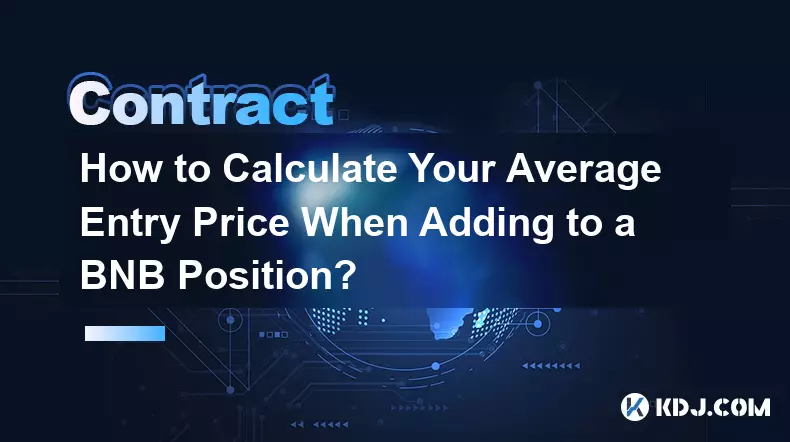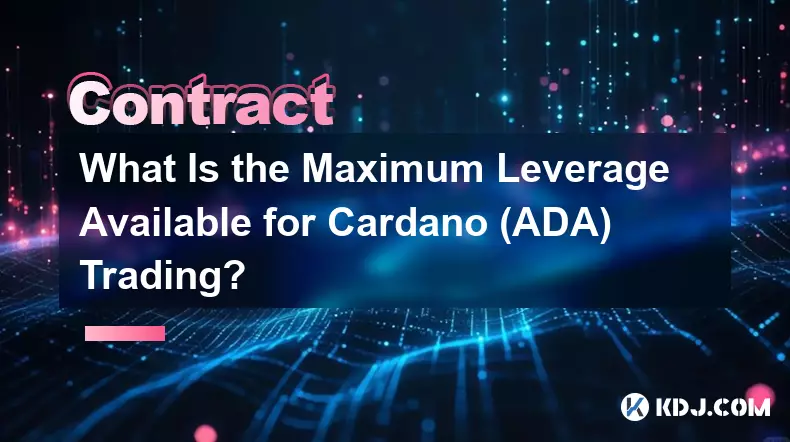-
 bitcoin
bitcoin $112139.774561 USD
-1.82% -
 ethereum
ethereum $3970.329568 USD
-3.85% -
 tether
tether $1.000078 USD
0.01% -
 xrp
xrp $2.611653 USD
-1.08% -
 bnb
bnb $1099.982737 USD
-3.67% -
 solana
solana $193.702075 USD
-3.33% -
 usd-coin
usd-coin $0.999832 USD
0.00% -
 dogecoin
dogecoin $0.193302 USD
-3.68% -
 tron
tron $0.294800 USD
-1.45% -
 cardano
cardano $0.642524 USD
-3.89% -
 hyperliquid
hyperliquid $47.524848 USD
1.27% -
 chainlink
chainlink $17.842256 USD
-2.41% -
 bitcoin-cash
bitcoin-cash $561.265025 USD
1.01% -
 stellar
stellar $0.317292 USD
-2.07% -
 ethena-usde
ethena-usde $0.999303 USD
0.01%
How is the maintenance margin for ETH contracts determined by exchanges?
Exchanges set ETH contract maintenance margins to prevent liquidations, using mark price and volatility metrics to ensure fair, stable margin enforcement.
Oct 25, 2025 at 07:37 am

Maintenance Margin Basics for ETH Contracts
1. Exchanges establish maintenance margin levels to ensure traders maintain sufficient equity in their accounts to cover potential losses. This threshold prevents abrupt liquidations and supports market stability.
2. For Ethereum futures and perpetual contracts, the maintenance margin is typically expressed as a percentage of the total position value. This percentage varies based on the exchange’s risk model and the volatility profile of ETH.
3. Highly leveraged positions require higher maintenance margins relative to their notional size. If a trader's account balance falls below this level after accounting for unrealized losses, the system triggers a margin call or automatic liquidation.
4. The calculation often includes factors such as recent price volatility, order book depth, and funding rate fluctuations specific to ETH pairs. These metrics help exchanges dynamically adjust thresholds during periods of turbulence.
5. Some platforms use fixed percentages—for example, 0.5% or 1%—while others implement tiered systems where larger positions face proportionally higher requirements to discourage excessive leverage concentration.
Exchange-Specific Risk Models
1. Major derivatives exchanges like Binance, Bybit, and OKX each deploy proprietary algorithms to determine maintenance margin rates. These models analyze historical volatility, average true range (ATR), and extreme price move simulations over rolling windows.
2. During high-volatility events—such as hard fork announcements or macroeconomic shocks—exchanges may temporarily increase maintenance margin requirements to mitigate systemic risk exposure across open positions.
3. Isolated margin modes usually set stricter maintenance levels compared to cross-margin configurations, since risk is confined to a single position rather than spread across the entire wallet balance.
4. Tiered maintenance structures mean that a 10 ETH position might be subject to a 1% requirement, while a 100 ETH position could require 1.5%, reflecting greater counterparty risk at scale.
5. Exchanges also consider liquidity conditions; if bid-ask spreads widen significantly on ETH/USDT order books, maintenance margins can be adjusted upward preemptively to protect against slippage during forced exits.
Role of Mark Price in Margin Calculations
1. To prevent manipulation through isolated trades, exchanges use a mark price derived from spot indices and funding rates when assessing whether maintenance margin levels are breached.
This mechanism ensures that liquidations occur based on fair value rather than fleeting market prints, reducing the chance of cascading wipes during flash crashes.2. The difference between entry price and mark price determines unrealized PnL, which directly impacts available margin. A sharp drop in the mark price can quickly erode equity even without trade execution.
3. Funding payments in perpetual contracts also affect effective margin levels. Long position holders paying high funding fees see their balances reduced incrementally, indirectly influencing proximity to maintenance thresholds.
Exchanges integrate these ongoing costs into real-time margin monitoring systems, recalculating thresholds every few seconds during active trading phases.4. When the wallet balance divided by the notional value of the position drops below the defined maintenance ratio, the system flags the account for liquidation unless additional funds are deposited immediately.
Liquidation Triggers and Buffer Mechanisms
1. Once the maintenance margin level is breached, most platforms initiate a liquidation sequence rather than closing positions instantly. This allows time for price recovery or user intervention.
2. Insurance funds maintained by exchanges absorb residual losses from undercollateralized positions, but only after all margin has been exhausted and the position is fully closed out.
Some exchanges incorporate a buffer zone above the theoretical liquidation price, giving traders a brief window to add margin before automated execution begins.3. Partial liquidation models are increasingly common—instead of closing the entire position, platforms may reduce leverage gradually by closing portions of large contracts to restore compliance with maintenance rules.
4. Transparency reports published by certain exchanges detail how frequently ETH contracts approach or breach maintenance levels, offering insight into default probabilities under various market regimes.
Frequently Asked Questions
What happens if my ETH contract falls below maintenance margin?The exchange will issue a margin call or begin liquidating your position. If using isolated margin, only that position is affected. In cross-margin mode, other assets in your wallet may be used to cover the shortfall.
Can maintenance margin requirements change during holding a position?Yes. Exchanges reserve the right to adjust maintenance margins dynamically based on network congestion, volatility spikes, or changes in underlying index pricing. Users must monitor these updates closely.
How do I calculate the maintenance margin for an ETH futures contract?Multiply the notional value of your position by the exchange-specified maintenance rate. For instance, a $50,000 ETH/USD contract with a 0.75% requirement needs $375 in equity to remain above the threshold.
Are maintenance margins the same across all ETH derivative products?No. Perpetual swaps, quarterly futures, and options contracts each carry distinct maintenance structures. Perpetuals often have tighter margins due to continuous funding mechanisms offsetting some risk.
Disclaimer:info@kdj.com
The information provided is not trading advice. kdj.com does not assume any responsibility for any investments made based on the information provided in this article. Cryptocurrencies are highly volatile and it is highly recommended that you invest with caution after thorough research!
If you believe that the content used on this website infringes your copyright, please contact us immediately (info@kdj.com) and we will delete it promptly.
- Essex Post Office, 5p Coins, and King Charles: A Royal Mint Revelation!
- 2025-10-23 10:30:16
- Waymo's Newark Airport AV Tests: Alphabet's AI Gamble Pays Off?
- 2025-10-23 10:30:16
- King Charles 5p Coins: A Royal Flush in Your Pocket?
- 2025-10-23 10:35:18
- Solana, Crypto Advisory, and Forward Industries: A New York Minute on the Future of Finance
- 2025-10-23 08:51:22
- MAGACOIN: Ethereum Whales Dive into the Hottest Presale of 2025
- 2025-10-23 08:51:22
- Kadena's End of the Road? KDA Token Plummets Amid Project Abandonment
- 2025-10-23 08:55:34
Related knowledge

How to Calculate Your Average Entry Price When Adding to a BNB Position?
Oct 28,2025 at 12:24am
Understanding the Concept of Average Entry Price1. The average entry price is a crucial metric for traders who accumulate positions in assets like BNB...

What Is the Maximum Leverage Available for Cardano (ADA) Trading?
Oct 26,2025 at 12:18pm
Understanding Leverage in Cardano (ADA) Trading1. Leverage allows traders to control a larger position using a smaller amount of capital. In the conte...

What Are the Fees Involved in Trading Solana (SOL) Perpetual Swaps?
Oct 26,2025 at 07:36am
Fees Structure in Solana Perpetual Swap Trading1. Trading perpetual swaps on Solana-based decentralized exchanges involves several types of fees that ...

How to Trade Ethereum (ETH) Breakouts with High Leverage Safely?
Oct 26,2025 at 02:19am
Understanding High Leverage in Ethereum Trading1. High leverage allows traders to control large positions with relatively small capital, amplifying bo...

What Is an Insurance Fund in Bitcoin (BTC) Derivatives Trading?
Oct 29,2025 at 08:18am
Understanding the Role of Insurance Funds in BTC Derivatives1. In Bitcoin derivatives trading, an insurance fund acts as a financial backstop designed...

How to Set Multiple Take-Profit Orders for a Single BNB Position?
Oct 27,2025 at 05:00pm
Understanding Multiple Take-Profit Strategies in BNB Trading1. Traders in the cryptocurrency market often seek to maximize gains while minimizing emot...

How to Calculate Your Average Entry Price When Adding to a BNB Position?
Oct 28,2025 at 12:24am
Understanding the Concept of Average Entry Price1. The average entry price is a crucial metric for traders who accumulate positions in assets like BNB...

What Is the Maximum Leverage Available for Cardano (ADA) Trading?
Oct 26,2025 at 12:18pm
Understanding Leverage in Cardano (ADA) Trading1. Leverage allows traders to control a larger position using a smaller amount of capital. In the conte...

What Are the Fees Involved in Trading Solana (SOL) Perpetual Swaps?
Oct 26,2025 at 07:36am
Fees Structure in Solana Perpetual Swap Trading1. Trading perpetual swaps on Solana-based decentralized exchanges involves several types of fees that ...

How to Trade Ethereum (ETH) Breakouts with High Leverage Safely?
Oct 26,2025 at 02:19am
Understanding High Leverage in Ethereum Trading1. High leverage allows traders to control large positions with relatively small capital, amplifying bo...

What Is an Insurance Fund in Bitcoin (BTC) Derivatives Trading?
Oct 29,2025 at 08:18am
Understanding the Role of Insurance Funds in BTC Derivatives1. In Bitcoin derivatives trading, an insurance fund acts as a financial backstop designed...

How to Set Multiple Take-Profit Orders for a Single BNB Position?
Oct 27,2025 at 05:00pm
Understanding Multiple Take-Profit Strategies in BNB Trading1. Traders in the cryptocurrency market often seek to maximize gains while minimizing emot...
See all articles









































































